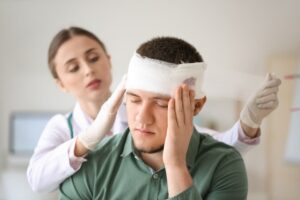Sometimes, when drivers cause an accident, they abruptly leave the scene. Following a hit and run, there are several important steps you can take, including speaking with witnesses, requesting a police report, and obtaining medical treatment for any injuries you suffered. It is also important that you contact a skilled car accident attorney in your area right away. Your lawyer can investigate your accident circumstances and file a claim with the appropriate insurance company for the compensation you need.
Table Of Content
Causes of Hit and Run Accidents
 Hit and run accidents are a significant concern on area roads, and several common factors contribute to their occurrence. One leading cause is impaired driving, often involving alcohol or drugs. When drivers operate vehicles while they are under the influence, their judgment, coordination, and reaction times become severely impaired. In the event of a collision, impaired drivers may flee the scene to avoid legal consequences, such as criminal DUI charges and administrative penalties.
Hit and run accidents are a significant concern on area roads, and several common factors contribute to their occurrence. One leading cause is impaired driving, often involving alcohol or drugs. When drivers operate vehicles while they are under the influence, their judgment, coordination, and reaction times become severely impaired. In the event of a collision, impaired drivers may flee the scene to avoid legal consequences, such as criminal DUI charges and administrative penalties.
Another common cause of hit and run accidents is distracted driving, which has become increasingly problematic with the rise of smartphones and other electronic devices in vehicles. When drivers divert their attention from the road to text, browse social media, or adjust navigation systems, they significantly increase the risk of collisions. Following an accident, distracted drivers may panic and choose to flee rather than confront the situation immediately.
Inexperience and reckless behavior are also significant contributors to hit and run accidents, particularly among young or novice drivers. Lack of driving experience can lead to poor decision-making and an inability to react appropriately in traffic situations. Additionally, drivers who engage in risky behaviors like speeding or aggressive driving are more likely to flee the scene after a collision.
Mechanical failures or vehicle defects can also play a role in hit and run accidents. Malfunctions such as brake failure or tire blowouts can lead to loss of control and subsequent collisions. In such situations, drivers may panic and leave the scene – especially if they lack the knowledge or resources to address the mechanical problem.
Furthermore, insurance-related issues can influence drivers’ decisions to flee after an accident. Individuals without proper insurance coverage may fear the financial and legal repercussions of being held liable for damages or injuries, prompting them to leave the scene to avoid discovery.
Situational factors, such as poor visibility or adverse weather conditions, can exacerbate the risk of hit and run crashes. Reduced visibility due to darkness, heavy rain, or fog makes it harder for drivers to perceive obstacles or other vehicles, increasing the likelihood of collisions. Additionally, poorly designed roadways, inadequate signage, or lack of proper lighting can create hazardous driving conditions, further contributing to these accidents.
If you suffered injuries in a recent hit and run accident, an experienced car accident attorney in your area can review your circumstances with you and determine your options for filing a claim or lawsuit seeking monetary recovery.
Common Injuries in a Hit and Run Accident
Hit and run accidents can result in various injuries, ranging from minor bruises to life-threatening conditions. Among the most common injuries are whiplash, fractures, head trauma, and internal injuries.
Whiplash is a prevalent injury in rear-end collisions, where the sudden impact causes the accident victim’s head and neck to jerk forward and backward rapidly. This can strain the neck ligaments and muscles, bringing about stiffness, pain, and limited range of motion. While whiplash injuries are often considered “minor,” they can cause significant discomfort and require ongoing medical treatment and physical therapy.
Fractures are another common injury in hit and run accidents, especially in high-speed collisions or crashes that involve pedestrians or cyclists. Broken bones can occur in various parts of the body, including the pelvis, arms, wrists, ribs, ankles, or legs. Depending on the severity of the fracture, treatment may require immobilization, surgery, and therapy.
 Head trauma is another serious concern in hit and run accidents. Traumatic brain injuries (TBIs) can range from mild concussions to severe brain damage, with symptoms including headaches, dizziness, confusion, disorientation, and loss of consciousness. Prompt medical attention is crucial for diagnosing and managing TBIs to prevent long-term (or permanent) memory losses and other complications.
Head trauma is another serious concern in hit and run accidents. Traumatic brain injuries (TBIs) can range from mild concussions to severe brain damage, with symptoms including headaches, dizziness, confusion, disorientation, and loss of consciousness. Prompt medical attention is crucial for diagnosing and managing TBIs to prevent long-term (or permanent) memory losses and other complications.
Internal injuries are often overlooked but can be life-threatening if left untreated. Blunt force trauma from a collision can cause damage to internal organs such as the liver, spleen, kidneys, or lungs. Internal bleeding, organ perforation, or other complications may not be readily apparent, but serious health complications can arise if the victim does not seek treatment immediately.
Soft tissue injuries, such as contusions, sprains, and strains, are also common in hit-and-run accidents. These injuries often affect muscles, ligaments, and tendons and can result in long-term swelling and pain. While soft tissue injuries may heal with proper rest and physical therapy, they can still cause the accident victim to experience significant discomfort and may affect their daily routines.
Psychological trauma is another consequence of hit-and-run accidents, particularly for survivors who may experience anxiety, depression, or post-traumatic stress disorder (PTSD). Witnessing or being involved in a traumatic event can have lasting psychological effects, requiring therapy and support to cope with the emotional aftermath.
Overall, hit-and-run accidents can lead to a wide range of injuries, from minor to severe, affecting victims physically, emotionally, and financially. Seeking medical attention and legal assistance following a hit-and-run collision is essential for ensuring proper diagnosis, treatment, and compensation for the injuries and damages incurred.
Steps to Take after a Hit and Run Collision
After being involved in a hit and run collision, there are several important steps you can take, including the following:
- Document the Accident Scene – Take photographs of the accident scene, including any damage to vehicles and surrounding property. Note the location, time, and date of the incident. Collecting evidence can help authorities investigate the incident and identify the responsible party.
- Exchange Information (If Possible) – If the other party is present, exchange contact and insurance information as you would in any other accident. However, if the other party is not available or has fled the scene, gather as much information as you can about the other vehicle, including its make, model, color, and license plate number. Witnesses to the accident can also provide valuable information.
- Report the Accident to Authorities – Report the hit-and-run accident to the police as soon as possible. Provide them with all of the details and evidence you’ve collected and request a copy of the police report.
- Notify Your Insurance Company – Contact your insurance company to report the accident and initiate the claims process. However, do not admit fault or say anything that may compromise your claim.
- Seek Medical Attention – If you believe you may have suffered injuries in the crash, seek medical attention promptly. Even if injuries seem minor at first, they can worsen over time. Documenting any injuries and receiving prompt medical treatment is essential for your well-being and any potential legal claims.
- Talk with a Car Accident Lawyer in Your Area – An experienced car accident lawyer can determine your eligibility for filing a claim – such as an uninsured motorist claim with your insurance company – and can handle every step of the process for you. Your lawyer can also pursue litigation options if the insurance company refuses to compensate you fairly for your losses.
Proving and Litigating a Hit and Run Car Accident Case
If you can identify the hit and run driver who caused your car accident, you can file a third-party claim with their insurance company seeking compensation. However, if you are unable to identify the responsible driver, you may pursue an uninsured motorist claim under your own car insurance policy.
 After initiating this claim, your attorney can handle all settlement negotiations for you. If the case still does not settle, then litigation may be a viable option:
After initiating this claim, your attorney can handle all settlement negotiations for you. If the case still does not settle, then litigation may be a viable option:
- Initiating Litigation – If a fair settlement offer cannot be reached through ongoing negotiations with the insurance company, your attorney may file a lawsuit in your case. This involves initiating litigation in civil court and formally serving the other party with the summons and complaint.
- Discovery Phase – During the discovery phase of litigation, both parties exchange evidence and information relevant to the case. This may include witness statements, expert testimony, and documentation of damages. Depositions may also be conducted, during which time witnesses and parties involved in the accident provide sworn testimony.
- Trial – If the case proceeds to trial, both sides present their arguments and evidence to a judge or jury. The judge or jury will then determine whether the other party is liable and, if so, the amount of damages owed to the injured accident victim.
- Appeals (if necessary) – In some cases, either party may choose to appeal the case decision. Higher courts usually hear appeals and focus on reviewing the legal process rather than re-litigating the facts of the case.
Proving and litigating a hit and run accident case requires patience, perseverance, and the help of experienced legal professionals. By following these steps and seeking the guidance of a qualified car accident attorney, you can pursue justice and compensation for the losses you suffered in your hit and run.
Recovering Favorable Monetary Damages after a Hit and Run Collision
After being involved in a hit and run accident, victims may be entitled to recover various types of damages to compensate for their losses. These damages can include:
- Medical Expenses – Victims of hit and run accidents often incur medical expenses for treatment of injuries sustained in the collision. This can include hospital bills, doctor visits, surgeries, medication costs, rehabilitation, and therapy expenses. Recovering medical expenses is crucial for ensuring that victims receive the necessary care and treatment to recover from their injuries.
- Lost Income – If the injuries sustained in the hit and run accident prevent the victim from working, they may be entitled to recover lost income. This can include income lost due to missed work days, as well as future earning capacity if the injuries result in a long-term disability or impairment that affects the victim’s ability to work.
- Pain and Suffering – Victims of hit and run accidents may also be entitled to receive compensation for the physical pain and emotional suffering they endure as a direct result of their injuries. Pain and suffering damages are intended to compensate victims for the physical discomfort, emotional distress, and diminished quality of life they experience due to the accident and resulting injuries.
- Property Damage – In addition to personal injuries, hit and run accidents often result in damage to the victim’s vehicle or other property. Victims can seek compensation for the cost of repairing or replacing their damaged property, including vehicle repairs, rental car expenses, and the value of any personal belongings damaged in the accident.
- Punitive Damages – In cases where the at-fault driver’s conduct was particularly egregious or reckless, victims may be awarded punitive damages in addition to compensatory damages. Punitive damages punish the defendant for their wrongful actions and deter similar behavior in the future.
Recovering damages after a hit and run accident can be a complex process, requiring thorough documentation of the victim’s injuries, financial losses, and other damages. It’s essential for victims to seek the assistance of an experienced personal injury attorney who can help them navigate the legal process, gather evidence to support their claims, and advocate for their rights.
By pursuing compensation for medical expenses, lost income, pain and suffering, property damage, and punitive damages, hit and run accident victims can seek to rebuild their lives and move forward after a traumatic and life-altering event. While no amount of money can undo the harm resulting from a hit and run, obtaining fair and just compensation can help victims recover financially and begin the healing process.
Contact an Experienced Car Accident Lawyer Today

Russell Reiner, Car Accident Attorney
If you suffered injuries in a hit and run car crash, an experienced personal injury lawyer can be extremely helpful. They can identify the best avenues for seeking the compensation you need when a liable driver does not have proper coverage. Your lawyer can file a timely claim or lawsuit on your behalf, negotiate with the proper insurance companies, and handle every step of the process.
Seek your free case evaluation today.
